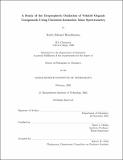| dc.contributor.advisor | Mario J. Molina. | en_US |
| dc.contributor.author | Broekhuizen, Keith Edward, 1974- | en_US |
| dc.contributor.other | Massachusetts Institute of Technology. Dept. of Chemistry. | en_US |
| dc.date.accessioned | 2005-05-19T14:39:59Z | |
| dc.date.available | 2005-05-19T14:39:59Z | |
| dc.date.copyright | 2002 | en_US |
| dc.date.issued | 2002 | en_US |
| dc.identifier.uri | http://hdl.handle.net/1721.1/16807 | |
| dc.description | Thesis (Ph.D.)--Massachusetts Institute of Technology, Dept. of Chemistry, 2002. | en_US |
| dc.description | Vita. | en_US |
| dc.description | Includes bibliographical references. | en_US |
| dc.description | This electronic version was submitted by the student author. The certified thesis is available in the Institute Archives and Special Collections. | en_US |
| dc.description.abstract | The mechanisms and kinetics of reactions important to the troposphere have been investigated using a high pressure, turbulent, discharge-flow technique coupled to a chemical ionization mass spectrometer. The ability to accurately model tropospheric chemistry depends on kinetic and mechanistic information for a wide variety of species. The gas-phase chemistry of the troposphere is dominated by the oxidation of trace species such as methane. One important intermediate in the oxidation of methane is the methylperoxy radical (CH302). The kinetic rate coefficient of the reaction of CH302 with NO was measured at 298 K and 100 Torr. The kinetics of the reaction of CH302 with HO2 were then examined. Aromatics are another important class of trace species found in the troposphere. The daytime oxidation of toluene is initiated by reaction with the OH radical. Rate coefficients and detailed mechanistic information for this oxidation pathway are poorly understood. The kinetics of the reaction of toluene with OH were measured at 298 K and 100 Torr. The detection of radical intermediates in this pathway was also accomplished using CIMS. Biogenic hydrocarbons also have complex oxidation mechanisms which are poorly understood. Many of these compounds are cyclic alkenes or dienes with complicated oxidation mechanisms. Propylene (C3H6) is a very simple alkene and can be studied as a proxy to larger biogenic compounds. The rate coefficient for the reaction of propylene with OH was measured at 100 Torr for a range of temperatures (235-305 K). | en_US |
| dc.description.abstract | (cont.) The rate coefficient for the reaction of the hydroxy-propylperoxy radical (CH3CH(OO)CH2OH) with NO was also measured at 100 Torr for a range of temperatures (235-305 K). This technique was also extended to the study of the important reaction of NO with the [beta]- or [delta]-hydroxy-peroxy radical formed in the oxidation of isoprene (C5H8OHO2) at 100 Torr and 298 K. | en_US |
| dc.description.statementofresponsibility | by Keith Edward Broekhuizen. | en_US |
| dc.format.extent | 176 p. | en_US |
| dc.format.extent | 1862556 bytes | |
| dc.format.extent | 1862306 bytes | |
| dc.format.mimetype | application/pdf | |
| dc.format.mimetype | application/pdf | |
| dc.language.iso | eng | en_US |
| dc.publisher | Massachusetts Institute of Technology | en_US |
| dc.rights | M.I.T. theses are protected by copyright. They may be viewed from this source for any purpose, but reproduction or distribution in any format is prohibited without written permission. See provided URL for inquiries about permission. | en_US |
| dc.rights.uri | http://dspace.mit.edu/handle/1721.1/7582 | |
| dc.subject | Chemistry. | en_US |
| dc.title | A study of the tropospheric oxidation of volatile organic compounds using chemical ionization mass spectrometry | en_US |
| dc.type | Thesis | en_US |
| dc.description.degree | Ph.D. | en_US |
| dc.contributor.department | Massachusetts Institute of Technology. Department of Chemistry | |
| dc.identifier.oclc | 50549676 | en_US |
